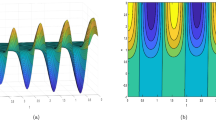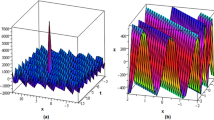Abstract
We propose a procedure for computing the direct scattering transform of the periodic sine-Gordon equation. This procedure, previously used within the periodic Korteweg–de Vries equation framework, is implemented for the case of the sine-Gordon equation and is validated numerically. In particular, we show that this algorithm works well with signals involving topological solitons, such as kink or anti-kink solitons, but also for non-topological solitons, such as breathers. It also has the ability to distinguish between these different solutions of the sine-Gordon equation within the complex plane of the eigenvalue spectrum of the scattering problem. The complex trace of the scattering matrix is made numerically accessible, and the influence of breathers on the latter is highlighted. Finally, periodic solutions of the sine-Gordon equation and their spectral signatures are explored in both the large-amplitude (cnoidal-like waves) and low-amplitude (radiative modes) limits.









Similar content being viewed by others
Data Availability Statement
No data associated in the manuscript.
References
J.S. Russell, Report on waves. Proc. R. Soc. Edinburgh 11, 319 (1844)
J. Frenkel, T. Kontorova, On the theory of plastic deformation and twinning. Izv. Akad. Nauk Ser. Fiz. 1, 137–149 (1939)
M. Remoissenet, Waves Called Solitons, 3rd edn. (Springer, Heidelberg, 1999)
T. Dauxois, M. Peyrard, Physics of Solitons (Cambridge University Press, Cambridge, 2006)
M.J. Ablowitz, H. Segur, Solitons and the Inverse Scattering Transform (Society for Industrial and Applied Mathematics, Philadelphia, 1981). https://doi.org/10.1137/1.9781611970883
P.G. Drazin, R.S. Johnson, Solitons: An Introduction (Cambridge University Press, Cambridge, 1989). https://doi.org/10.1017/CBO9781139172059
A.R. Osborne, Nonlinear Ocean Waves and the Inverse Scattering Transform (Academic Press, London, 2010)
P. Suret, M. Dufour, G. Roberti, G. El, F. Copie, S. Randoux, Soliton refraction by an optical soliton gas. Phys. Rev. Res. 5, L042002 (2023). https://doi.org/10.1103/PhysRevResearch.5.L042002
I. Redor, E. Barthélemy, H. Michallet, M. Onorato, N. Mordant, Experimental evidence of a hydrodynamic soliton gas. Phys. Rev. Lett. 122, 214502 (2019). https://doi.org/10.1103/PhysRevLett.122.214502
P. Suret, A. Tikan, F. Bonnefoy, F. Copie, G. Ducrozet, A. Gelash, G. Prabhudesai, G. Michel, A. Cazaubiel, E. Falcon, G. El, S. Randoux, Nonlinear spectral synthesis of soliton gas in deep-water surface gravity waves. Phys. Rev. Lett. 125, 264101 (2020). https://doi.org/10.1103/PhysRevLett.125.264101
A. Tikan, F. Bonnefoy, G. Roberti, G. El, A. Tovbis, G. Ducrozet, A. Cazaubiel, G. Prabhudesai, G. Michel, F. Copie, E. Falcon, S. Randoux, P. Suret, Prediction and manipulation of hydrodynamic rogue waves via nonlinear spectral engineering. Phys. Rev. Fluids 7, 054401 (2022). https://doi.org/10.1103/PhysRevFluids.7.054401
A.C. Scott, A nonlinear Klein–Gordon equation. Am. J. Phys. 37(1), 52–61 (1969). https://doi.org/10.1119/1.1975404
A.V. Ustinov, Solitons in Josephson junctions. Phys. D 123(1), 315–329 (1998). https://doi.org/10.1016/S0167-2789(98)00131-6
V.G. Ivancevic, T.T. Ivancevic, Sine-Gordon solitons, kinks and breathers as physical models of nonlinear excitations in living cellular structures. J. Geom. Symmetry Phys. 31, 1–56 (2013). https://doi.org/10.7546/jgsp-31-2013-1-56
B.A. Malomed, In: Cuevas-Maraver, J., Kevrekidis, P.G., Williams, F. (eds.) The sine-Gordon Model: General Background, Physical Motivations, Inverse Scattering, and Solitons (Springer, Cham, 2014), pp. 1–30. https://doi.org/10.1007/978-3-319-06722-3_1
M.J. Ablowitz, D.J. Kaup, A.C. Newell, H. Segur, Method for solving the sine-Gordon equation. Phys. Rev. Lett. 30, 1262–1264 (1973). https://doi.org/10.1103/PhysRevLett.30.1262
L.A. Takhtadzhyan, L.D. Faddeev, Essentially nonlinear one-dimensional model of classical field theory. Theoret. Math. Phys 21, 160–174 (1974). https://doi.org/10.1007/BF01035551
M.G. Forest, D.W. McLaughlin, Spectral theory for the periodic sine-Gordon equation: A concrete viewpoint. J. Math. Phys. 23(7), 1248–1277 (1982). https://doi.org/10.1063/1.525509
C.S. Gardner, J.M. Greene, M.D. Kruskal, R.M. Miura, Method for solving the Korteweg–de Vries equation. Phys. Rev. Lett. 19, 1095–1097 (1967). https://doi.org/10.1103/PhysRevLett.19.1095
E.A. Overman II., D.W. McLaughlin, A.R. Bishop, Coherence and chaos in the driven damped sine-Gordon equation: Measurement of the soliton spectrum. Phys. D 19(1), 1–41 (1986). https://doi.org/10.1016/0167-2789(86)90052-7
R. Flesch, M.G. Forest, A. Singha, Numerical inverse spectral transform for the periodic sine-Gordon equation: Theta function solutions and their linearized stability. Phys. D Nonlinear Phenom. 48(1), 169–231 (1991). https://doi.org/10.1016/0167-2789(91)90058-H
F. Novkoski, C.-T. Pham, E. Falcon, Experimental observation of periodic Korteweg–de Vries solitons along a torus of fluid. Europhys. Lett. 139(5), 53003 (2022). https://doi.org/10.1209/0295-5075/ac8a12
A.R. Osborne, Automatic algorithm for the numerical inverse scattering transform of the Korteweg–de Vries equation. Math. Comput. Simulat. 37(4), 431–450 (1994). https://doi.org/10.1016/0378-4754(94)00029-8
Y.S. Kivshar, B.A. Malomed, Z. Fei, L. Vázquez, Creation of sine-Gordon solitons by a pulse force. Phys. Rev. B 43, 1098–1109 (1991). https://doi.org/10.1103/PhysRevB.43.1098
A. Barone, F. Esposito, C.J. Magee, A.C. Scott, Theory and applications of the sine-Gordon equation. Riv. del Nuovo Cim. 1(2), 227–267 (1971). https://doi.org/10.1007/BF02820622
P. Suret, S. Randoux, A. Gelash, D. Agafontsev, B. Doyon, G. El, Soliton gas: Theory, numerics and experiments. arXiv:2304.06541v1 (2023)
Acknowledgements
This work is supported by the French National Research Agency (ANR SOGOOD project No. ANR-21-CE30-0061-04), and by the Simons Foundation MPS No 651463-Wave Turbulence.
Author information
Authors and Affiliations
Corresponding author
Appendices
Appendix A
As a comparison with the results on the different solitons and periodic solutions to the pSG equation discussed in the main text, we here include the half-trace obtained for a sine wave of amplitude \(A=0.01\), with \(k=2\) and \(\omega =1\) on a domain of length \(L=60\). The real and imaginary parts of the trace are shown in Fig. 10 for the negative real part of the energy plane, where we observe that there is no pinching. In Fig. 11 we show the same quantity for the positive real part of the energy plane.
Appendix B
In this appendix, we discuss how the domain size L and the spatial discretization \(\Delta x\) affect the eigenvalues of a single infinite-line truncated kink soliton. We start varying L while keeping \(\Delta x\) fixed at 0.02. Its energy has been chosen to be \(E=1\). We can see in Fig. 12a that as the domain size L is increased, the results become more accurate. This is due to the fact that the errors due to periodicity (i.e. the mismatch at the domain ends) decreases. In Fig. 12b, we have kept the domain size value at \(L=20\) and changed the discretization \(\Delta x\). As expected, by decreasing the value of \(\Delta x\), the energies converge to a single value.
Rights and permissions
Springer Nature or its licensor (e.g. a society or other partner) holds exclusive rights to this article under a publishing agreement with the author(s) or other rightsholder(s); author self-archiving of the accepted manuscript version of this article is solely governed by the terms of such publishing agreement and applicable law.
About this article
Cite this article
Novkoski, F., Falcon, E. & Pham, CT. A numerical direct scattering method for the periodic sine-Gordon equation. Eur. Phys. J. Plus 138, 1146 (2023). https://doi.org/10.1140/epjp/s13360-023-04706-7
Received:
Accepted:
Published:
DOI: https://doi.org/10.1140/epjp/s13360-023-04706-7







